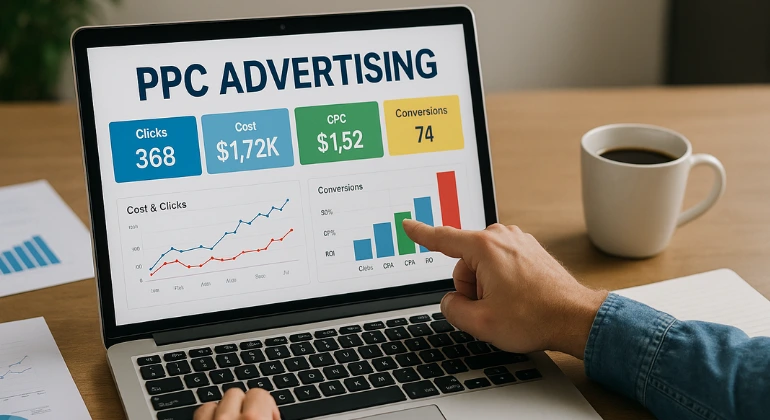There is no item in your cart
Introduction to Pay Per Click Advertising
In today’s fast-paced digital world, getting noticed online is more competitive than ever. That’s where pay per click advertising steps in. Unlike organic traffic, which takes time to grow, pay per click advertising gives you instant visibility and results. Whether you’re a startup, freelancer, or marketing student, understanding how ppc advertising works is essential in today’s digital marketing landscape.
Pay per click (PPC) means you only pay when someone clicks on your ad. It’s a targeted way to reach potential customers actively searching for what you offer. With the right strategy, even a small budget can yield impressive returns.
How PPC Advertising Works
Understanding the mechanics of ppc advertising is the first step to making it work for your business. Platforms like Google Ads, Facebook Ads, and LinkedIn Ads allow advertisers to bid on keywords and place ads in search results or user feeds. The cost you pay depends on the competition for that keyword and your ad quality.
Each time someone searches a term or visits a page where your ad can appear, a real-time auction happens. If your pay per click advertising bid wins and your ad is relevant, it gets displayed. You pay only when someone engages with your ad by clicking on it.
This model of pay per click ensures that your marketing budget goes toward actual potential leads, not just views. It’s scalable, measurable, and highly effective for businesses looking to grow online quickly.
Benefits of PPC Marketing for Businesses
There are many reasons why ppc marketing is a powerful tool for businesses. One of the biggest advantages is visibility. Your ad appears at the top of search results, above organic listings. This increases your chances of getting noticed—fast.
Another benefit of pay per click advertising is precise targeting. You can control who sees your ad based on demographics, location, time, and even device. This helps you connect with your ideal customer more effectively.
Ppc marketing also provides real-time data. You can track clicks, conversions, and cost per acquisition, giving you the flexibility to adjust your campaigns instantly. Whether you’re selling a product, offering services, or promoting content, ppc marketing helps drive measurable growth.
Finally, it complements your long-term SEO efforts. While SEO builds organic reach, ppc advertising brings in immediate traffic, helping you balance short-term wins with long-term goals.
Crafting a Winning PPC Strategy
A successful ppc strategy begins with clear objectives. Do you want more traffic, leads, or sales? Defining your goal helps shape everything else—your keywords, targeting, and budget.
Keyword research is a core part of any ppc strategy. Use tools like Google Keyword Planner or Ubersuggest to find high-intent keywords that align with your offering. Avoid broad or irrelevant terms that waste your budget.
Targeting is also crucial. Segment your audience based on behavior, interests, and demographics. A strong ppc strategy focuses on reaching the right people at the right time.
Next comes ad creation. Write compelling headlines, use emotional triggers, and always include a clear call-to-action (CTA). Make sure your landing pages are optimized for speed, relevance, and conversions.
Finally, monitor and optimize. A great ppc strategy isn’t static—it evolves. Analyze your data, test different ad variations (A/B testing), and refine your targeting to improve performance continuously.
Common Mistakes to Avoid in Pay Per Click Advertising
Even though pay per click campaigns are powerful, many marketers make avoidable mistakes. One of the most common is bidding on too many broad or unrelated keywords. This leads to irrelevant traffic and poor ROI.
Another major error is sending users to a generic or low-quality landing page. Your ad and landing page must be aligned in message and design. A mismatch leads to high bounce rates and wasted clicks in ppc advertising.
Not tracking conversions is another mistake. You must set up conversion tracking to understand what’s working. Otherwise, you’re flying blind with your pay per click advertising efforts.
Overlooking mobile users can also hurt your campaign. Make sure your ads and landing pages are mobile-friendly. Today, a large chunk of ppc marketing traffic comes from mobile devices.
Lastly, failing to test and optimize. Many advertisers launch a campaign and forget it. Regular performance reviews and tweaks are essential to improving your ppc strategy over time.
Explore WoonBicx Courses
Pay per click is one of the most cost-effective ways to bring in fast, targeted traffic to your business or personal brand. Whether you’re looking for more leads, better engagement, or quick visibility, ppc marketing offers a direct path to achieving your goals.
With the right ppc strategy, consistent optimization, and attention to detail, anyone can master the art of pay per click advertising. It’s not just for big brands—freelancers, students, and small business owners can all leverage it effectively.
At WoonBicx, we simplify PPC for learners and professionals alike. Our expert-led courses and training programs help you master everything from campaign setup to analytics. If you’re ready to take control of your digital presence and see real results—
Join WoonBicx — your trusted institute for PPC advertising and digital marketing in Delhi.



Leave A Comment